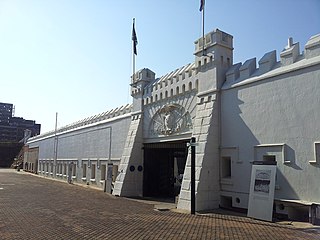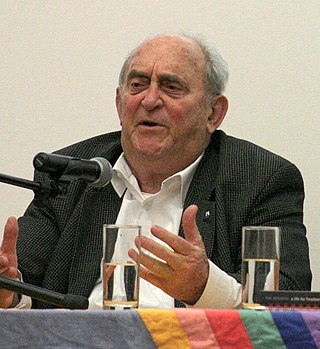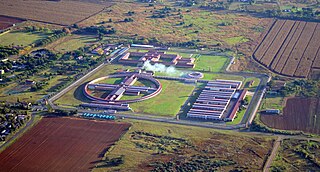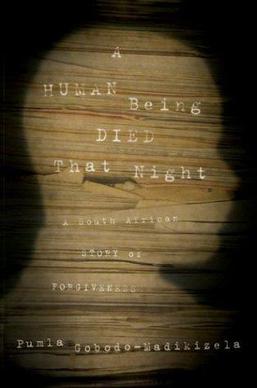The Rivonia Trial was a trial that took place in apartheid-era South Africa between 9 October 1963 and 12 June 1964, after a group of anti-apartheid activists were arrested on Liliesleaf Farm in Rivonia. The farm had been the secret location for meetings of uMkhonto we Sizwe (MK), the newly-formed armed wing of the African National Congress. The trial took place in Pretoria at the Palace of Justice and the Old Synagogue and led to the imprisonment of Nelson Mandela, Walter Sisulu, Govan Mbeki, Ahmed Kathrada, Denis Goldberg, Raymond Mhlaba, Elias Motsoaledi, Andrew Mlangeni. Many were convicted of sabotage and sentenced to life.
Raymond Mphakamisi Mhlaba OMSG was an anti-apartheid activist, Communist and leader of the African National Congress (ANC) also as well the first premier of the Eastern Cape. Mhlaba spent 25 years of his life in prison. Well known for being sentenced, along with Nelson Mandela, Govan Mbeki, Walter Sisulu and others in the Rivonia Trial, he was an active member of the ANC and the South African Communist Party (SACP) all his adult life. His kindly manner brought him the nickname "Oom Ray".
Abraham Louis Fischer was a South African Communist lawyer of Afrikaner descent with partial Anglo-African ancestry from his paternal grandmother, notable for anti-apartheid activism and for the legal defence of anti-apartheid figures, including Nelson Mandela, at the Rivonia Trial. Following the trial, he was himself put on trial accused of furthering communism. He was sentenced to life imprisonment and diagnosed with cancer while in prison. The South African Prisons Act was extended to include his brother's house in Bloemfontein where he died two months later.

Ahmed Mohamed Kathrada OMSG, sometimes known by the nickname "Kathy", was a South African politician and anti-apartheid activist.

The Constitution Hill precinct is located at 11 Kotze Street in Braamfontein, Johannesburg near the western end of the suburb of Hillbrow. Constitution Hill is the seat of the Constitutional Court of South Africa.
Pollsmoor Prison, officially known as Pollsmoor Maximum Security Prison, is located in the Cape Town suburb of Tokai in South Africa. Pollsmoor is a maximum security penal facility that continues to hold some of South Africa's most dangerous criminals. Although the prison was designed with a maximum capacity of 4,336 offenders attended by a staff of 1,278, the current inmate population is over 7,000.
Elias Mathope Motsoaledi OMSG was a South African anti-apartheid activist. He was Accused No.9 in the Rivonia Trial and was sentenced to life imprisonment in July 1963 with a group of anti-Apartheid revolutionaries which included Nelson Mandela who was Accused No.1.

Denis Theodore Goldberg was a South African social campaigner, who was active in the struggle against apartheid. He was accused No. 3 in the Rivonia Trial, alongside the better-known Nelson Mandela and Walter Sisulu, where he was also the youngest of the defendants. He was imprisoned for 22 years, along with other key members of the anti-apartheid movement in South Africa. After his release in 1985 he continued to campaign against apartheid from his base in London with his family, until the apartheid system was fully abolished with the 1994 election. He returned to South Africa in 2002 and founded the non-profit Denis Goldberg Legacy Foundation Trust in 2015. He was diagnosed with lung cancer in July 2017, and died in Cape Town on 29 April 2020.
The Department of Correctional Services is a department of the South African government. It is responsible for running South Africa's prison system. The department has about 34,000 staff and is responsible for the administration of 240 prisons, which accommodates about 189,748 inmates. The prisons include minimum, medium and maximum security facilities. The agency is headquartered in the West Block of the Poyntons Building in Pretoria.
Annanias Mathe, sometimes spelled Ananias Mathe, was a notorious serial rapist and armed robber from Mozambique who achieved further notoriety in 2006 by being the only person to have ever escaped from the maximum high-security C-Max Penitentiary in Pretoria, South Africa.

Prisons in South Africa are run by the Department of Correctional Services. The department is divided into six administrative regions, each with its own regional commissioner, and subdivided into multiple areas, each headed by an area commissioner. According to the ministry, there are approximately 34,000 employees of the department running 240 prisons. In those prisons are nearly 156,000 inmates as of August 2013. The prisons include minimum, medium, maximum and super-maximum security facilities. They may be entirely dedicated to a specific group of prisoners, such as women or children, or be divided into separate sections for each group. Since 2019, the Minister of Correctional Services has been Ronald Lamola.
The Little Rivonia Trial was a South African apartheid-era court case in which several members of the armed resistance organization Umkhonto we Sizwe faced charges of sabotage. The accused were: Laloo Chiba, Dave Kitson, Mac Maharaj, John Matthews and Wilton Mkwayi. A confederate of theirs, Lionel Gay turned state witness, and in return, the prosecution dropped the charges against him.

A Human Being Died That Night is a 2003 book by Pumla Gobodo-Madikizela.

Timothy Peter Jenkin is a South African writer, anti-apartheid activist and former political prisoner. He is best known for his 1979 escape from Pretoria Local Prison, along with Stephen Lee and Alex Moumbaris.
Jane Furse is a town in the Sekhukhune District Municipality of the Limpopo province in South Africa, surrounded by the villages of Ga-Moretsele, Madibong, Marulaneng, Mamone, Mokwete and Riverside.
Andrew Mokete Mlangeni, also known as Percy Mokoena, Mokete Mokoena, and Rev. Mokete Mokoena, was a South African political activist and anti-apartheid campaigner who, along with Nelson Mandela and others, was imprisoned after the Rivonia Trial.

Sonia Bunting, OLS was a South African journalist, and a political and anti-apartheid activist. After being charged with treason and imprisoned, being detained a second time, and barred from publishing, she and her husband went into exile in London, where she joined the Anti-Apartheid Movement (AAM) and organised the World Campaign for the Release of South African Political Prisoners. When the African National Congress (ANC) ban was lifted in 1991, she returned to South Africa where she was involved in political activism until her death in 2001. She was posthumously honored by the government of South Africa with the Order of Luthuli in Silver in 2010.

Robben Island Prison is an inactive prison on Robben Island in Table Bay, 6.9 kilometers (4.3 mi) west of the coast of Bloubergstrand, Cape Town, South Africa. Nobel Laureate and former President of South Africa Nelson Mandela was imprisoned there for 18 of the 27 years he served behind bars before the fall of apartheid. Since then, three former inmates of the prison have gone on to become President of South Africa.
Stephen Bernard Lee is a South African former political prisoner best known for his 1979 escape from Pretoria Local Prison with friend and fellow activist Tim Jenkin and a third inmate, Alex Moumbaris.
Mampuru II was a king of the Pedi people in southern Africa. Mampuru was a son of the elder brother of Sekwati and claimed he had been designated as his successor.








